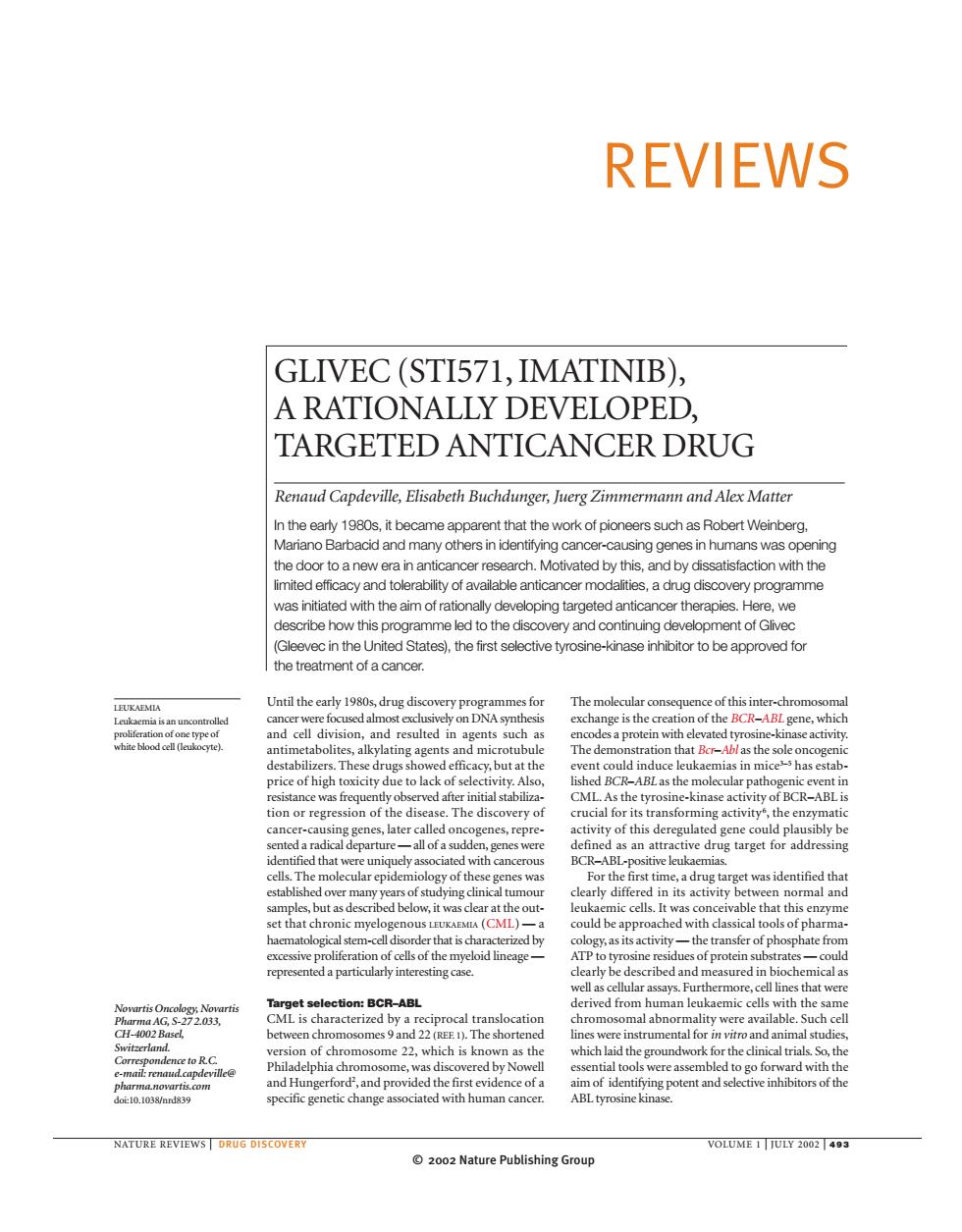正在加载图片...

REVIEWS GLIVEC (STI571,IMATINIB). A RATIONALLY DEVELOPED TARGETED ANTICANCER DRUG Renaud Capdeville,Elisabeth Buchdunger,Juerg Zimmermann and Alex Matter n the early 1980s.it became apparent that the work of pioneers such as Robert Weinbera Mariano Barbacid and many others in identifying cancer-causing genes in humans was opening the door to a new era in anticancer research.Motivated by this,and by dissatisfaction with the limited efficacy and tolerability of available anticancer modaities,adrug discovery programme was initiated with the aim of rationally developing targeted anticancer therapies.Here,we describe how this programme led to the discovery and continuing development of Givec Gleevec in the United States),the first selective tyrosine-kinase inhibitor to be approved for treatment of a cancer. The molecular conse ence of this inter-c ts such a price of high or regre n of t di The discoveryo rucial fo ch. For th mpls,butasdcsaibcdbeioci da) e that thi d by red in cal a :BCR-ABL d from uman leu Theshortene ta for n I stud击i d with th do:10-103m3 specific genetic change URE REVIEWS OLUME I IULY 2002 2002 Nature Publishing Group© 2002 Nature Publishing Group REVIEWS Until the early 1980s, drug discovery programmes for cancer were focused almost exclusively on DNA synthesis and cell division, and resulted in agents such as antimetabolites, alkylating agents and microtubule destabilizers. These drugs showed efficacy, but at the price of high toxicity due to lack of selectivity. Also, resistance was frequently observed after initial stabilization or regression of the disease. The discovery of cancer-causing genes, later called oncogenes, represented a radical departure — all of a sudden, genes were identified that were uniquely associated with cancerous cells. The molecular epidemiology of these genes was established over many years of studying clinical tumour samples, but as described below, it was clear at the outset that chronic myelogenous LEUKAEMIA (CML) — a haematological stem-cell disorder that is characterized by excessive proliferation of cells of the myeloid lineage — represented a particularly interesting case. Target selection: BCR–ABL CML is characterized by a reciprocal translocation between chromosomes 9 and 22 (REF. 1). The shortened version of chromosome 22, which is known as the Philadelphia chromosome, was discovered by Nowell and Hungerford2 , and provided the first evidence of a specific genetic change associated with human cancer. The molecular consequence of this inter-chromosomal exchange is the creation of the BCR–ABL gene, which encodes a protein with elevated tyrosine-kinase activity. The demonstration that Bcr–Abl as the sole oncogenic event could induce leukaemias in mice3–5 has established BCR–ABL as the molecular pathogenic event in CML. As the tyrosine-kinase activity of BCR–ABL is crucial for its transforming activity 6 , the enzymatic activity of this deregulated gene could plausibly be defined as an attractive drug target for addressing BCR–ABL-positive leukaemias. For the first time, a drug target was identified that clearly differed in its activity between normal and leukaemic cells. It was conceivable that this enzyme could be approached with classical tools of pharmacology, as its activity — the transfer of phosphate from ATP to tyrosine residues of protein substrates — could clearly be described and measured in biochemical as well as cellular assays. Furthermore, cell lines that were derived from human leukaemic cells with the same chromosomal abnormality were available. Such cell lines were instrumental for in vitro and animal studies, which laid the groundwork for the clinical trials. So, the essential tools were assembled to go forward with the aim of identifying potent and selective inhibitors of the ABL tyrosine kinase. GLIVEC (STI571, IMATINIB), A RATIONALLY DEVELOPED, TARGETED ANTICANCER DRUG Renaud Capdeville, Elisabeth Buchdunger, Juerg Zimmermann and Alex Matter In the early 1980s, it became apparent that the work of pioneers such as Robert Weinberg, Mariano Barbacid and many others in identifying cancer-causing genes in humans was opening the door to a new era in anticancer research. Motivated by this, and by dissatisfaction with the limited efficacy and tolerability of available anticancer modalities, a drug discovery programme was initiated with the aim of rationally developing targeted anticancer therapies. Here, we describe how this programme led to the discovery and continuing development of Glivec (Gleevec in the United States), the first selective tyrosine-kinase inhibitor to be approved for the treatment of a cancer. NATURE REVIEWS | DRUG DISCOVERY VOLUME 1 | JULY 2002 | 493 Novartis Oncology, Novartis Pharma AG, S-27 2.033, CH-4002 Basel, Switzerland. Correspondence to R.C. e-mail: renaud.capdeville@ pharma.novartis.com doi:10.1038/nrd839 LEUKAEMIA Leukaemia is an uncontrolled proliferation of one type of white blood cell (leukocyte)